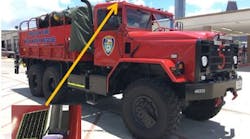Batteries play a critical role in providing a safe, comfortable and efficient experience for commercial vehicle drivers. Not only do they power the starting system, they also supply energy to all of the electrical components. Developing a solid preventive maintenance program where batteries are checked on a regular basis can help identify battery problems early, helping to prevent costly no-start situations and battery-related breakdowns.
Although there are a variety of battery types, the most commonly used in North American fleets are flooded, absorbed glass mat (AGM) and thin plate pure lead (TTPL) AGM.
- Flooded lead acid batteries. These batteries contain a liquid solution made up of approximately 35 percent sulfuric acid and 65 percent distilled water. This battery allows the flow of electrons between two different metals when they are immersed in the electrolyte. This battery option is typically the least expensive.
- AGM batteries. In AGM batteries, the electrolyte is held by an absorbent glass mat material that also acts as a separator. This microfiber glass mat ensures constant contact between plates and the absorbed electrolyte. These batteries offer improved starting and cycling performance.
- TTPL AGM batteries. These batteries are a type of AGM battery with thinner plates that allow more plates to be placed in a given volume, allowing more acid-to-plate contact area to create more current-carrying capacity. This allows better cycling and can translate to a longer service life.
“Most commercial vehicles utilize 12V starting and charging systems, consistent with automotive applications,” says Jim O’Hara, Clore Automotive’s vice president of marketing. Clore Automotive (cloreautomotive.com) designs and manufactures battery service equipment. “Where commercial vehicles typically vary from automotive is in the total battery capacity of the vehicle. Commercial vehicles typically have multiple large batteries, which presents diagnostic and maintenance challenges.”
The number of batteries used depends on the size of the vehicle.
“Small to medium box trucks generally use two batteries, and vocational applications like heavy duty dump trucks, waste haulers, cement mixers and over-the-road tractor-trailers use three to four batteries,” explains Bruce Essig, EnerSys’ Odyssey Battery national program manager for transportation and specialty. EnerSys (enersys.com) manufactures and distributes reserve power and motive power batteries, battery chargers, power equipment and battery accessories.
Connecting multiple 12V batteries together in parallel creates more cranking power for the significantly larger, more powerful engines, and increases the amp-hour rating. Essig says that output amperage on small vehicles can be less than 100 amps – it goes up to 300 amps on large heavy duty trucks, and some applications, such as transit buses, can have over 500 amps of output.
Every time the vehicle is stopped, then started, amperage is drawn from each battery. This becomes a challenge in vehicles that stop and start frequently, especially those in areas with anti-idle laws, where they must be completely turned off.
“If the next stop is a short distance away, the alternator won’t have the time or the capability to replace the energy taken from the battery,” says Bobbie DuMelle, executive vice president for CTEK Inc. CTEK (smartercharger.com) manufactures a range of battery chargers and accessories for private and professional use. “Over the course of a day, a commercial vehicle could stop and restart more than 30 times. The charge within the battery will become lower and lower, placing it at risk of sulfation or failure.”
Because this type of application creates so much demand on the batteries, these vehicles may benefit from using AGM or TTPL AGM batteries, which offer improved cycling and more efficient recharge, helping to prolong the life of the battery.
“The deeper cycling capabilities of AGMs offer the same power to run important amenities without the fuel costs and emissions associated with idling,” says John Bania, heavy duty and commercial director of power solutions for Johnson Controls. Johnson Controls (johnsoncontrols.com) manufactures lead-acid automotive batteries and advanced batteries for hybrid and electric vehicles.
“New anti-idling laws aim to reduce fuel costs and emissions, and have led the industry to seek new ways to power driver amenities during rest periods,” Bania adds.
This creates extra battery strain for sleeper cabs, in addition to vehicles that make frequent stops.
“Typically, in sleeper trucks, those batteries are going to get discharged more deeply at night, whenever the person’s not driving,” says A.J. Palmisano, business unit manager of integrated solutions at Midtronics. Midtronics (midtronics.com/transportation) offers a range of battery testers, charging equipment and complete battery management programs. “When the batteries are discharged too deeply, it may prevent [the driver] from starting the truck.”
Palmisano adds that there are several options that can help fleets avoid deeply discharging batteries overnight. Battery monitoring systems can monitor the batteries and have the vehicle start on its own to recharge the batteries before they become discharged too deeply. Another option is to use shore power by plugging the truck’s inverter/charger in overnight, drawing power from the electrical grid instead of the batteries to run whatever needs power, without the vehicle engine on for an extended period of time.
Some fleets install auxiliary power units (APUs), instead of using the engine batteries. Powered by the vehicle’s diesel fuel or its own battery power source, APUs are generators that provide electrical energy to the truck.
In trucks where key-off electrical energy needs are high, an auxiliary battery pack may also be added. Since these batteries are not used for cranking, they can be discharged more deeply. Many trucks have a separator between the starting batteries and the auxiliary batteries. If the auxiliary batteries get discharged, the separator opens to prevent draining the starting batteries, so the vehicle will still be able to start in the morning.
“Some companies will make trucks that will automatically restart if they’re in a no-idle situation and the battery starts to get low,” Palmisano notes. “They’ll charge the batteries to roughly 80 percent, and maybe let them get as low as 40 percent. You need a battery monitor for that, but then the truck will only run as long as it needs to (in order) to charge the batteries, and then it shuts off on its own.”
These precautions, in conjunction with regular battery maintenance, can help limit battery-related breakdowns.
Battery maintenance best practices
As a general rule, fleets should check batteries for physical damage during routine maintenance, and dispose of any batteries that are damaged, says Zena Johnson, marketing manager of PulseTech Products Corp. PulseTech (PulseTech.net) offers a variety of products for maximizing battery performance and minimizing battery-related expenses.
“Whenever a vehicle is in the shop for routine maintenance, it’s important to test both the battery voltage and cold cranking amps for each battery,” Johnson says. “If the voltage and/or cold cranking amps are low, remove the battery from the vehicle and connect it to a recovery charger for at least 48 hours. Then, test the battery again to make sure it’s ready to go back into use.”
Johnson adds that it is not enough to just charge the batteries – fleets must also clean the sulfate crystals that build up on the battery plates, or they will eventually choke and kill the battery.
“For example, PulseTech’s chargers have one circuit for charging the battery, plus another separate circuit for their patented Pulse Technology, which removes sulfates from the battery plates and prevents new ones from forming,” she says. Keeping batteries clean of sulfate buildup can help maximize the battery life.
Typical commercial vehicle usage patterns result in a low state of charge for the battery pack, says Clore’s O’Hara.
“Proactively charging the battery pack using a high rate charger every time it is in for periodic service is an essential practice,” he says. “It should be as automatic as changing fluids. Doing so will return the pack to full charge, which helps extend battery life.”
It’s important to note that fleets should use an AGM-compatible charger when charging AGM or TTPL AGM batteries, as these batteries can accept a very high charge rate. Using a compatible charger helps avoid excessive voltage and overcharging, which can damage the battery.
“If a fleet has a unique duty cycle where the batteries could sit for longer periods of time, maintenance charging is recommended,” adds Johnson Controls’ Bania.
Jeff Coleman, vice president sales for original equipment at East Penn (eastpennmanufacturing.com), suggests running through the following checklist with each regularly scheduled PM service:
- Check and confirm the state of charge of the battery pack (prior to charging). Make sure to check the state of charge of the battery and recharge if necessary before and after PM, service or extended periods of non-use. “We have seen multiple occasions where the batteries have been discharged to the point of failure from draws or parasitic leads related to scheduled maintenance,” Coleman says.
- Check and confirm the security of hold-downs. If the battery is not secured properly, it can experience extra vibration and jolting that can damage the battery.
- Clean all terminal connections (studs or posts and cable lugs). Road dirt and grime/grease will reduce charge acceptance. Also inspect battery cables for wear or damage and replace if necessary.
- When recharging, make sure to use charging adapters on all stud battery posts. “This is very important,” Coleman says. “Make sure the charging adapters are screwed tight on the stud so there is a good lead-to-lead contact between the post bushing and charging adapter.”
CTEK’s DuMelle adds that it is also important to ensure that paired batteries are balanced.
“Paired batteries working in either a series or parallel system should be within an acceptable operating range of one another. If there is too much of an imbalance (one has a significantly higher voltage than the other), you may very quickly experience battery failure,” DuMelle says. “After charging batteries, make sure you retest them before they leave the shop to make sure the batteries are a good match.”
An additional maintenance step for some flooded batteries is that they need to have water added occasionally, notes Midtronics’ Palmisano. AGM and TTPL AGM batteries don’t require this, so it is an extra maintenance step for that specific battery type.
In addition, it’s also becoming more common to check the reserve capacity (RC), Palmisano says. RC is a time measurement of how long a fully-charged battery can deliver 25 amps of current in an 80 degree F environment before the battery is discharged down to 10.5V. This is distinct from cold cranking amps (CCA), which measures how much power a battery is capable of delivering in short bursts.
“The most thorough check for RC would be to charge the battery all the way up, then discharge it all the way down,” Palmisano says. “In a maintenance environment, that’s not really practical. But, there are some testers that have the ability to tell you whether the RC is good or bad.”
Palmisano recommends that fleets follow TMC’s RP129A every three months to ensure optimal battery performance and catch battery issues before they result in battery-related downtime.
Actual battery replacement intervals will vary based on fleet practices.
“Age does not indicate the state of a battery and whether it needs replacement,” PulseTech’s Johnson says.
“Battery life will be dependent on usage cycles and usage profiles,” Coleman adds. “The correct battery in the right application, that is properly maintained, can see a [longer product life]. A battery that is not maintained properly will see a much shorter lifespan.”
The way batteries are used, the frequency of the power drawn from them and how deeply they are discharged all have an effect on a battery’s life, making it difficult to determine a regular interval at which they should be replaced.
EnerSys’ Essig suggests keeping track of average failure service times for the fleet’s application.
“It’s good preventive maintenance to replace batteries 60 to 90 days prior to these failure timeframes,” he says. “This can help prevent unexpected no-starts, especially on trucks out on a delivery or on the road.”
Regular battery testing provides parameters to help accurately predict the end of life for batteries. “Tracking battery metrics such as derived CCA, internal resistance and state-of-health using an electronic battery testing solution can allow a service operation to monitor battery health and predict the best time for battery replacement,” Clore’s O’Hara adds.
Warning signs that it may be time to change the battery include a check engine light, corrosion on terminals and cables, and slow cranking, says Johnson Controls’ Bania. If the driver notes that the vehicle is sluggish when starting, or that accessories aren’t running as long before the low voltage disconnect engages, this can be a sign that it is time to replace the battery.
“Don’t wait [to take action] until the vehicle shows signs of a weak battery – that may be too late,” CTEK’s DuMelle concludes. “By testing, charging and conditioning batteries on a regular basis, shops can identify any battery problems to ensure that fleet vehicles are protected against electrical non-starts and other battery-related breakdowns.”




